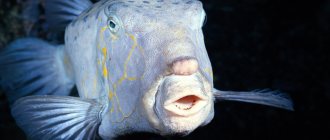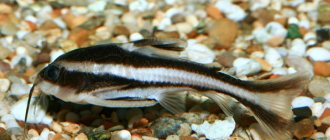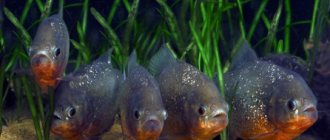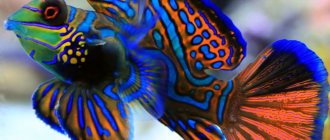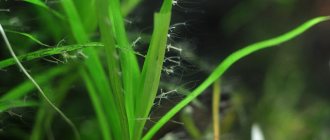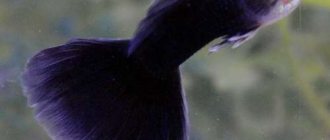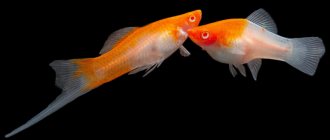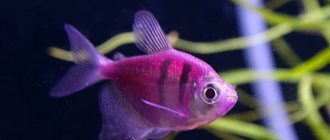Home » Other animals
Although today you can keep rare reptiles and amphibians such as salamanders , centipedes , axolotls, geckos and chameleons , aquarium fish still come first.
There are more than a dozen species of aquarium fish; photos with names and descriptions of some of them can be examined in more detail.
Each species can include from 3 to 30 or more subspecies.
You can read about other common aquarium inhabitants here:
- 2 American cichlids
- 3 African cichlids
- 4 Loaches
- 5 Viviparous
- 6 Carp
- 7 Danio
- 8 Labeo
- 9 Labyrinth
- 10 Unusual fish
- 11 Rainbows
- 12 Soms
- 13 Brackish water
- 14 Tetradons
- 15 Characins
Apistograms
Bolivian butterfly
Our list of “Aquarium fish” opens with the beautiful Bolivian butterfly, which is calm and peaceful, so it gets along well with other relatives
A beautiful, small (up to 9 cm) and very peaceful fish that brings joy to its owner.
It is very easy to keep, even together with other species. It has enough intelligence to recognize its owner and ask him for food.
Apistogramma of a cockatoo
Apistogramma cockatoo is a small predator. This must be kept in mind when placing it in the same aquarium with other fish.
Belongs to the dwarf species of cichlids. Very bright in appearance, but not very popular among fish lovers.
At a young age there are no bright colors, so it does not catch the eyes of buyers. It is a predator, so it can eat fry and small crustaceans.
Compatibility
Keeping several species of fish should be based on their compatibility in size and character . Pelvicachromis can frighten calm small fish with its activity.
Large underwater inhabitants will keep the parrots in anticipation of danger and will easily bring them to stress.
The following species get along best with Pelvicachromis:
- thorns;
- swordtails;
- barbs;
- zebrafish;
- gourami;
- corridors;
- other dwarf cichlids.
The main thing is to provide a sufficient amount of water for each fish so that they do not feel cramped.
American cichlids
Angelfish
Angelfish are quite popular among domestic aquarists
A very large and voracious representative of cichlids.
The body is tall with a variety of colors, which makes this fish very popular among aquarists.
New colorful species of angelfish are easily developed.
Cichlazoma salvini
Cichlasoma salvini can coexist only with fish of the same species, or is completely alone
Aggressive, medium-sized (up to 22 cm) predator. They are kept only separately or with relatives.
At a young age it is inconspicuous, but as it matures it acquires a very beautiful color that catches the eye.
Red parrot
The red parrot is a loving but shy fish
Artificially bred hybrid. Has huge unusual lips that form a triangle mouth. The color is bright orange, monochromatic.
Being large in size, they have a timid disposition, so they cannot be kept in the same aquarium with aggressive fish.
If you are interested in looking at huge freshwater fish, we recommend that you read the article
Christopher Columbus was the first to talk about the anomalies of the Bermuda Triangle
0
Source:
In 1492, Christopher Columbus wanted to find a new route to Asia and discovered America. Columbus was the first known explorer to cross the area of the Atlantic that we now call the Bermuda Triangle. His ship's log contains a description of the sea, completely filled with algae, a story about the unusual behavior of the compass needle, about the sudden appearance of a huge tongue of flame, about the strange glow of the sea.
×
African cichlids
Frontosa
Frontosa is a large fish that needs a lot of space
A favorite of experienced aquarists, frontosa reaches 35 cm in length, so it needs a voluminous aquarium.
It's hard not to notice this bright blue with black and white stripes high-browed beauty among other fish.
Princess of Burundi
Princess of Burundi - a real aristocrat
This is a person of royal blood. At least that's what she looks like.
The golden color and long luxurious fins combined with a graceful elongated body make it very attractive in a flock of its own kind.
Blue dolphin
Aquarium fish Blue Dolphin really look like real dolphins
Blue dolphins are cichlids, aquarium fish, the photo with the name of which indicates an external resemblance to a dolphin.
The reason for this is a fatty growth on the forehead. They are loved for their original blue tint and unusual appearance.
Photo and description of Discus
We offer you photos and descriptions of aquarium discus fish for your reference. Fishes are very loved by many aquarists, and many do not recognize anyone else at all. Yes, the fish are very impressive, which is noticeable from the photo, but keeping them requires appropriate knowledge and even some skills.
Green discus
Green discus has a characteristic color - green-turquoise shades with black splashes. These fish grow up to a diameter of 15 centimeters in an aquarium. They are very sensitive to water and its parameters, so keeping these fish must be taken very seriously.
Red discus
The classic color for discus fish is red. Such fish require an aquarium volume of at least 100 liters. In general, as you already understand, this fish is not for beginners.
Heckel's discus
These fish are distinguished by their turquoise color with black vertical stripes. If you keep a flock of such fish in a 400-500 liter aquarium, then you will captivate any of your guests with the beauty of the aquarium.
Loaches
Befortia
Befortia can be found both in the wild and in the home aquarium.
A very unusual fish, similar to a flounder or stingray. In nature, it lives in fast and clean water.
Its body size reaches no more than 8 cm. It intrigues with its flat appearance and spotted coloring on a light brown background.
Botia clown
Botia clown got its name from its motley clown coloring
This representative of the loaches has a pronounced personality and incomparable coloring, which is dominated by blue and yellow stripes encircling it in a circle.
Individuals are quite large, up to 20 cm in length.
Conditions of detention
The parrotfish is very hardy, and this fact plays a major role in its popularity among aquarists. However, there are several rules that must be followed to successfully keep Pelvicachromis pulcher. For a “parrot” the following conditions are required:
The soil should be of medium fraction, not sharp
Water requirements for different species are slightly different, so it is better to clarify the main parameters when purchasing fish at a pet store. The generally accepted standards for each variety are as follows:
The diet should be varied and include alternation of different types
Pelvicachromis nutrition
These representatives of cichlids spend the main part of their lives at the bottom of the reservoir, and accordingly, they find food there.
In general, they are omnivores, so they will happily eat both fresh and frozen food.
However, the diet should be varied and include alternation of different types. This will have a good effect on the immunity, well-being and color of the fish. What does Pelvicachromis eat:
Compatibility with other aquatic inhabitants
In general, “parrots” are quite peaceful, but we should not forget that they are still representatives of the cichlid family, which can hardly tolerate strangers on their territory. What suits them best as neighbors are fish of the same size, but living in separate water layers. Good compatibility of Pelvicachromis pulcher with the following species:
- cichlids of other species;
- mossy and Sumatran barbs;
- swordtails;
- Congo;
- mollies.
Good compatibility of Pelvikachromis pulcher with molynesias and barbs.
It is very important that the aquarium is not overcrowded, and that the “parrot” has its own territory and shelters. It is not recommended to house more than a couple of cichlids in one “house”, otherwise it will be difficult for them to divide their possessions. It is also undesirable for slow-swimming fish to live next to the pelvicachromis, as this risks having their fins and tails bitten off. Small shrimp will also be in the field of view of the “parrot” due to the latter’s predatory nature.
Particular aggressiveness towards strangers manifests itself during reproduction. Pelvikachromis very fiercely guards the shelter in which the female and the fry are located. There are also frequent fights between the parents of the young (in such clashes, each defends their right to raise the younger generation).
Viviparous
Guppy
Guppies are the most popular aquarium fish.
Guppy fish are the most famous representative of viviparous fish.
The appearance of these small (up to 5 cm) fish is very difficult to describe, since they often interbreed, forming different shades of silver and golden colors.
These aquarium fish, photos with names of which are most recognizable to beginning aquarists, can boast of excellent fertility and unpretentiousness.
sword bearer
The swordtail is perhaps the second most popular aquarium fish after the guppy.
It got its name from the long growth on the caudal fin of males. The colors of these fish vary, but are always bright.
Excellent reproduction and unpretentiousness are a distinctive feature of swordtails.
Goldfish and others
Golden
Classic goldfish belong to the genus crucian carp. They can come in a variety of colors and grow to different sizes depending on the size of the aquarium. The classic color is red and gold. A very ancient breed of fish, for which it requires exceptional respect.
Golden Veiltail
Veiltails are a separate species of goldfish. The photo shows how the veil-shaped caudal fin develops. When choosing such fish to keep, be sure to choose the right neighbors, as other fish may bite the tail of the golden one.
Koi carp
A fairly large breed of fish, which is why they like to be kept in ponds. In the photo you see their characteristic color – white with bright spots of different colors. The fish are not whimsical, but the volume of the aquarium is the only and important parameter for them.
Telescope
Telescopes come in gold and black. As a rule, they are not very large in size, up to 10-12 cm, so they can live in aquariums from 60 liters. The fish is spectacular and unusual, suitable for those who love everything original.
Oranda fish - red cap
Some people find this fish extremely charming, while others may, on the contrary, consider it defective. And all because of the specific cap on top of the head - it’s a small growth, and not necessarily red. One thing is for sure, that the fish is unusual, but you yourself know the taste and color.
Carp
Cherry barb
The cherry barb has a bright and attractive appearance
A small fish of dark red color. Easy to breed and very active.
It is recommended to keep the barb with similar active fish.
Pangasius
It turns out that Pangasius can be found not only in restaurant menus, but also in aquariums
Due to its resemblance to a shark, it gave itself a second name - shark catfish. In the wild there are individuals up to 130 centimeters in length.
The silver color and high fins actually give it a shark-like appearance.
Cardinal
The cardinal is a fish species that has almost disappeared from nature.
A species almost extinct in nature. The fish are no more than 4 cm in length, brown in color, with a fluorescent stripe running along the body.
They feed from the surface of the water, which is why their mouth is oriented upward.
Disappearance of crews
0
Source:
In 1872, the Mary Celeste sailed from Staten Island, New York, to the port of Genoa, Italy. On the ship, in addition to the captain and a crew of 7 people, there was the captain’s wife and his two-year-old daughter. The ship was discovered 4 weeks later, without a crew. At the same time, provisions, personal belongings, money and jewelry remained untouched. And the arrangement of things indicated that the ship was not caught in a strong storm.
Danio
Danio malabar
Malabar Danio is a calm and peace-loving fish
The largest of all zebrafish (up to 15 cm). A peaceful and calm fish, very rarely found among hobbyists.
Colors can range from green to blue. They do not require special care, the main thing is that the water is clean.
Danio leopard
The leopard danio is colored in the form of dots on an orange background, which resembles a leopard
An artificially bred hybrid from zebrafish. It is colored in the form of dots on an orange background, which resembles a leopard.
Easy to grow and does not require special attention.
In the Bermuda Triangle area, the compass shows the wrong direction
0
Source:
Compasses in this area behave strangely and give incorrect readings. It is generally accepted that the Earth's electromagnetic field has holes. There are a large number of areas on Earth where a compass will not point due north. So the Bermuda Triangle is not the only place on the planet where similar anomalies occur.
Labeo
Labeo two-color
Labeo bicolor behaves very actively in the aquarium
It has a very unusual coloring. A black body and orange tail are a distinctive feature of the bicolor, as it is also called.
The shape of the body is similar to that of a shark. The fish are very active in aquariums.
Labeo green
Labeo green - a hooligan and cocky representative of the aquarium world
A hooligan and cocky representative of the labeo, with a body length of up to 15 cm. The body of the fish is elongated, gray-green in color with orange fins.
It is not recommended for beginners to breed, as it is whimsical and very pugnacious and does not get along well with other fish.
Pecilia
Like Guppies, Pecilia is not inferior in popularity. Belongs to the family of viviparous fish. The platie is native to Central America and is a very sociable ornamental fish that prefers to be close to its group at the surface of the water.
Pecilia is available in many different colors. Due to its ease of maintenance, it is also popular among beginners and beginners in the aquarium hobby.
- Origin: Mexico along the Atlantic coast to Honduras.
- Length: up to 7 cm.
- Swimming area: medium.
- Content difficulty: easy.
- Capacity: freshwater and for a comfortable life 1 liter per 1 individual.
- Water parameters: from +22°C to +27°C, pH value from 7 to 8.
- Socialization: Pecilia gets along with guppies, catfish, snails and many other peaceful freshwater animals. However, in the presence of larger species, Pecilia can become shy.
- Food: dry and live food, as well as algae.
- Features: a healthy Pecilia is always on the move and rarely hides. However, there should be escape points through small-leaved or floating plants. It multiplies quickly, so you need to keep an eye on it.
Labyrinthine
Kissing gourami
The kissing gourami is shaped like kissing lips, which is where its name comes from.
They were named so because of a strange ritual similar to a kiss. In an aquarium, fish measure up to 12 - 15 cm.
Individuals of pink color are more common, but there are also greenish ones. This species requires a very large aquarium.
Cockerels
Cockerels are the most beautiful aquarium fish
Like all labyrinth fish, it is capable of breathing oxygen from the atmosphere.
It has a very bright coloring with long, luxurious fins.
It got its name because of the fierce fights to the death between males.
Time Portal
0
Source:
In 1970, Bruce Gernon, along with his father and a friend, flew from the Bahamas and headed for Miami Beach, Florida, USA. Shortly after gaining altitude, the pilot noticed a strange semicircular cloud directly ahead. There were bright flashes inside the cloud, Gernon and the passengers felt a feeling similar to weightlessness. All navigation instruments were out of order, the compass needle was throwing in all directions. When the plane took off from that tunnel, Bruce saw that it was already approaching Miami Beach. Moreover, the flight took only 45 minutes, although it should have lasted at least 75!
Unusual fish
Kalamoicht calabarensis
Kalamoicht calabar looks like a small snake
Snake fish is its second name. This ancient fish looks very unusual. The golden, serpentine body of this fish reaches 40 centimeters.
Can breathe oxygen by sticking its head to the surface of the water.
It is unpretentious, but requires keeping with the same or larger fish, as it preys on small ones.
Elephant fish
The elephant fish has an unusual appearance and a proboscis like that of an elephant.
This shy and interesting fish looks so unusual that not everyone may like it.
Her lower lip is very long and curves down almost at a right angle. Hence the name. Keeping an elephant is very difficult.
Atlantis at the bottom of the Bermuda Triangle
0
Source:
Studies of the ocean floor off the coast of Cuba using a deep-sea robot have confirmed that at the very bottom of the Bermuda Triangle there is a city of gigantic proportions. Scientists suggest that this is Atlantis. “The US government obtained evidence of the existence of an underwater city during the Cuban Missile Crisis in the 1960s. The nuclear submarine was then moving along the Gulf Stream deep in the sea, where they discovered the structure of the pyramids. They immediately took control of the place so that it would not fall into the hands of the Soviet Union,” the journalists claim.
Rainbows
Neon rainbow
The neon iris is very whimsical and capricious, it can jump out of the water
Dwarf, 5 - 6 cm in length, a fish with bright pinkish-gray scales with iridescence.
The neon effect is created at different angles of light incidence.
Very whimsical and capricious, can jump out of the water. Needs a large aquarium.
Iriaterina Werner
Iriaterina Werner has a slim and toned body
This graceful fish amazes with its beauty. With a small (5 cm) size, it looks elongated and slender.
Coloring may vary. It depends on the habitat and nutrition.
Soma
Catfish changeling
The catfish got its name from its love of swimming belly up
This catfish got its name from its love of swimming upside down. A very slow, mustachioed nocturnal fish, constantly hiding in shelters.
For this reason, there should be enough of them in the aquarium.
The fish will definitely eat less of themselves at night, so you need to keep the catfish with large individuals.
Speckled catfish
Speckled catfish is perfect for beginner aquarists
A very peaceful and easy to breed catfish. The sand-colored body is covered with dark specks. The length reaches 7 cm.
The body is covered with bone plates. The antennae are used to search for food in bottom sediments.
Requires soft soil rich in nutrients.
Brackish water
Splashfish
The squirt fish sprays a thin stream of water at insects, thereby knocking them down and eating them
Loves brackish water. It can spit a stream of water at insects, knocking them down and eating them.
The fish is silver in color with dark spots on the back.
It is quite difficult to keep and breed, so it is recommended only for experienced aquarists.
They get along well with other fish if they behave calmly.
Anomalies occur not only in the Bermuda Triangle
0
Source:
The Devil's Sea is how Japanese fishermen dubbed the Pacific waters around the island of Miyakejima (128 km south of Tokyo), located in the northern part of the Philippine Sea. Researchers of paranormal activity bring this zone closer to the Bermuda Triangle for the reason that ships and planes mysteriously disappear in it.
Tetradons
Tetradon dwarf
Tetradon dwarf is distinguished by the fact that it is able to move its eyes independently of each other
The smallest of all tetradons (2.5 cm). It has a very bright and attractive coloring.
Very smart fish, watching what is happening behind the glass of the aquarium. They differ in that they are able to move their eyes independently of each other.
The color varies according to mood from brown to green.
